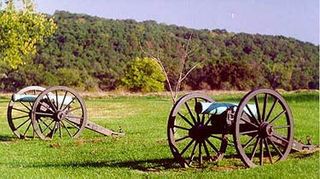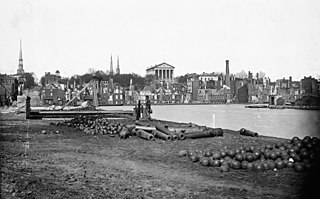Related Research Articles

The Battle of the Crater was a battle of the American Civil War, part of the siege of Petersburg. It took place on Saturday, July 30, 1864, between the Confederate Army of Northern Virginia, commanded by General Robert E. Lee, and the Union Army of the Potomac, commanded by Major General George G. Meade.

Wilson's Creek National Battlefield, located near Republic, Missouri, preserves the site of the Battle of Wilson's Creek. Fought on August 10, 1861, the battle was the first major American Civil War engagement west of the Mississippi River. In the battle, a Confederate army commanded by Benjamin McCulloch and Sterling Price defeated a smaller Union army commanded by Nathaniel Lyon. However, the Confederates were unable to hold much of Missouri, and a Confederate defeat at the Battle of Pea Ridge effectively solidified Union control of the state. Major features include a five-mile automobile tour loop, the restored 1852 Ray House, and "Bloody Hill," the site of the final stage of the battle. The site is located near Republic in southwestern Missouri just southwest of the city of Springfield. It has been a unit of the National Park Service since 1960, and was listed on the National Register of Historic Places in 1966.

Richmond, Virginia served as the capital of the Confederate States of America for almost the whole of the American Civil War. It was a vital source of weapons and supplies for the war effort, and the terminus of five railroads.

Robert Boisseau Pamplin Jr. is an American businessman, philanthropist, and minister. He is also noted as an educator, historical preservationist and author.

Perryville Battlefield State Historic Site is a 745-acre (3.01 km2) park near Perryville in Boyle County, Kentucky. The park continues to expand with purchases of parcels by the Office of Kentucky Nature Preserves' Kentucky Heritage Land Conservation Fund and the American Battlefield Trust. An interpretive museum is located near the site where many Confederate soldiers killed in the Battle of Perryville were buried. Additionally, monuments, interpretive signage, and cannons mark notable events that occurred during the battle. The site became part of the Kentucky State Park System in 1936.
Interstate 85 (I-85) is a part of the Interstate Highway System that runs from Montgomery, Alabama to Petersburg, Virginia. In Virginia, the Interstate Highway runs 68.64 miles (110.47 km) from the North Carolina state line near Bracey north to I-95 in Petersburg. I-85 passes through the eastern part of Southside Virginia, where it parallels U.S. Route 1 from Petersburg, where the highway runs concurrently with US 460, to south of South Hill, where the highway intersects Southside's major east–west highway, US 58. The Interstate Highway is the primary connection between the Richmond–Petersburg metropolitan area and the Research Triangle and other major metropolitan areas of North Carolina. Like all mainline Interstate Highways, I-85 is a part of the National Highway System for its entire length in Virginia.

High Bridge is a historic former railroad bridge across the Appomattox River valley about 6 miles (9.7 km) east, or downstream, of the town of Farmville in Prince Edward County, Virginia. The remains of the bridge and its adjacent rail line are now a rail trail park, High Bridge Trail State Park.

Fort Foote was an American Civil War-era wood and earthwork fort that was part of the wartime defenses of Washington, D.C., which helped defend the Potomac River approach to the city. It operated from 1863 to 1878, when the post was abandoned, and was used briefly during the First and Second World Wars. The remnants of the fort are located in Fort Foote Park, which is maintained by the U.S. National Park Service as part of the National Capital Parks-East system. The area's mailing address is Fort Washington, Maryland.

The Petersburg Breakthrough Battlefield is a historic district in Dinwiddie County, near Petersburg, Virginia. It was the location of the Third Battle of Petersburg, in which the Union Army broke through Confederate Army lines protecting Petersburg and Richmond on April 2, 1865, during the American Civil War. The success of the breakthrough led to abandonment of Richmond by General Robert E. Lee, a general retreat, and surrender at Appomattox Court House one week later. Portions of the area were listed on the National Register of Historic Places in 2003, and a different portion was designated a National Historic Landmark in 2006. Much of the battlefield area is part of Pamplin Historical Park, a private park open to the public that interprets the battle. The park includes a full-service visitor center, trails, displays, interpretive signs and history programs. The Civil War Trust and its partners have acquired and preserved 407 acres (1.65 km2) of the Breakthrough battlefield in five transactions since 2004.

Sailor's Creek Battlefield Historical State Park is a 321-acre (130 ha) state park in Rice, Virginia,. It includes a portion of the landmarked Sayler's Creek Battlefield, an area of 1,022 acres (414 ha) that was the site of the April 6th, 1865 Battle of Sayler's Creek, one of the last major engagements in the Eastern Theater of the war during Confederate General-in-Chief Robert E. Lee (1807-1870), during his week-long retreat to the southwest in the final Appomattox campaign from the fallen Confederate capital at Richmond and nearby Petersburg, before his subsequent surrender three days later at Appomattox Court House to pursuing Union Army General-in-Chief Ulysses S. Grant (1822-1885), on April 9, 1865, effectively ending the American Civil War (1861-1865).
Don Troiani is an American painter whose work focuses on his native country's military heritage, mostly from the American Revolution, War of 1812 and American Civil War. His highly realistic and historically accurate oil and watercolor works are most well known in the form of marketed mass-produced printed limited-edition reproductions, illustrated books, book compilations, museum and government collections. He is also a militaria collector.

The commemoration of the American Civil War is based on the memories of the Civil War that Americans have shaped according to their political, social and cultural circumstances and needs, starting with the Gettysburg Address and the dedication of the Gettysburg cemetery in 1863. Confederates, both veterans and women, were especially active in forging the myth of the Lost Cause of the Confederacy.
The Civil War Trust's Civil War Discovery Trail is a heritage tourism program that links more than 600 U.S. Civil War sites in more than 30 states. The program is one of the White House Millennium Council's sixteen flagship National Millennium Trails. Sites on the trail include battlefields, museums, historic sites, forts and cemeteries.

Pamplin Historical Park is a 424-acre private sector historical park located near Petersburg, Virginia. The park preserves open space near Richmond, Virginia in Dinwiddie County, Virginia and serves the dual use of preserving a significant fragment of the Petersburg Breakthrough Battlefield, a National Historic Landmark, and key components of the Third Battle of Petersburg. The park also provides a footprint location for the National Museum of the Civil War Soldier, which is located within the park.

Allen Wilson Greene, also known as Will Greene, is an American historian, author, and retired museum director. Greene was the director of the Association for the Preservation of Civil War Sites. Later, he became director of Pamplin Historical Park and the National Museum of the Civil War Soldier in Petersburg, Virginia. He also served on the national oversight board for the Institute of Museum and Library Services Over the years, Greene has made ten appearances on C-SPAN.

The practice of preserving the battlefields of the American Civil War for historical and memorial reasons has been developed over more than 150 years in the United States. Even during the American Civil War active duty soldiers on both sides of the conflict began erecting impromptu battlefield monuments to their recently fallen comrades. Since these initial attempts at preservation and commemoration, important Civil War battle sites have been preserved by various groups and many are now in the care of the National Park Service and overseen by the American Battlefield Protection Program (ABPP). Of approximately 10,500 acts of aggression that occurred between the United States and the Confederacy 384 have been identified in a 1993 federal report as being principle to the conflict. From these a select few have been chosen based on their historical significance, accessibility, and preservability to be federally curated. Beyond sites run by the U.S. Federal government many secondary battle sites across the United States are maintained and operated by state governments and private historical groups.
References
- ↑ "Pamplin Park". Civil War Times Illustrated . Retrieved 2012-09-30.
- ↑ "Trial by Fire". Pamplin Historical Park & The National Museum of the Civil War Soldier.
- ↑ Johnson, Clint (2011). Touring Virginia's and West Virginia's Civil War Sites. John F. Blair. p. 335.
- 1 2 Johnson, Clint (2005). 25 Best Civil War Sites. ASDavis Media Group. p. 45.
- ↑ Weeks, Michael (2009). The Complete Civil War Road Trip Guide . The Countryman Press. pp. 264.
National Museum of the Civil War Soldier.
- ↑ "Park History". Pamplin Historical Park and The National Museum of the Civil War Soldier. Retrieved 2012-09-30.
- ↑ "Smithsonian Journeys Experts—A. Wilson Greene", Smithsonian Journeys, Smithsonian Institution, Washington, District of Columbia, accesses 27 March 2017.
- ↑ Lange, Chris, "A. Wilson Greene stepping down a quarter century after starting Pamplin Park", Progress-Index, Petersburg, Virginia, 9 April 2017.